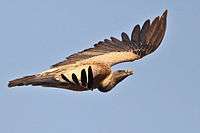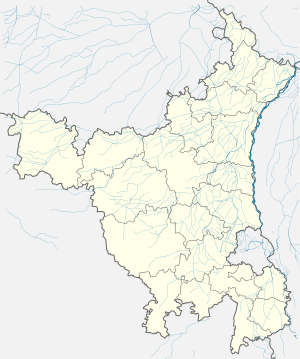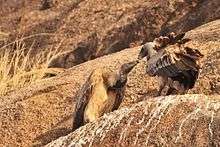Jatayu Conservation Breeding Centre, Pinjore
The Jatayu and Sparrow Conservation Breeding Centre, Pinjore (JCBC), (Hindi: जटायु संरक्षण एवं प्रजनन केँद्र) is world's largest[1] facility within Bir Shikargah Wildlife Sanctuary for the breeding and conservation of Indian vultures (गिध) and House sparrow (Passer domesticus चिड़िया) in the State of Haryana, India, in Panchkula district in the town of Pinjore.[2][3][4] It is run by the Forests Department, Haryana and Bombay Natural History Society (BNHS) with the help of British charity Royal Society for the Protection of Birds (RSPB).[5] It is located within the Bir Shikargah Wildlife Sanctuary 8 kilometres (5.0 mi) away from Pinjore on Pinjor-Mallah Road,[3] 30 kilometres (19 mi) from Chandigarh, 20 kilometres (12 mi) from Panchkula, 250 kilometres (160 mi) from New Delhi, 10 kilometres (6.2 mi) from Kalka and 20 kilometres (12 mi) from Morni Hill station.
Jatayu Conservation and Breeding Centre जटायु संरक्षण एवं प्रजनन केँद्र | |
|---|---|
Critically Endangered Bird Breeding Centre | |
 Indian vulture in flight | |
 Jatayu Conservation and Breeding Centre Location in Haryana, India  Jatayu Conservation and Breeding Centre Jatayu Conservation and Breeding Centre (India) | |
| Coordinates: 30°46′7″N 76°57′19″E | |
| Country | |
| State | Haryana |
| District | Panchkula |
| Founded by | Former Chief Minister of Harayana Om Prakash Chautala |
| Named for | Jatayu |
| Government | |
| • Type | Government of Haryana |
| • Body | Forests Department, Haryana |
| Time zone | UTC+5:30 (IST) |
| Website | haryanaforest |
History
Vultures
Asia's first vulture breeding facility JCBC was established in 2001, named after the mythical vulture Jatayu from the Hindu epic Ramayana,[6] is a joint project of the Forests Department, Haryana and the Bombay Natural History Society.[7] It covers 5 acres (2.0 ha), and its focus is the conservation, study, and breeding of critically endangered and threatened species of vultures on the IUCN Red List.[1]
Fossil records of earlier types of vultures have been found going as far back as 20 million years ago, from which the Gyps species evolved representing majority of the vultures in the Indian subcontinent,[8][9][10] which live in the nests or ledges on the high cliff faces in social groups of typically 20 to 30 and even up to 100 vultures, with nests made from the wool, skin, dung and refuse.[11] Vultures are scavengers with high tolerance for the deadly pathogen found in their primary meal of rotting bodies of dead animals.[12]
Out of 40 million vultures population of India in 1993,[13] 99.9% of Slender-billed vultures and 97% White-backed vulture have disappeared from their primary habitat by 2007, due to the use of anti-inflammation drug diclofenac used to treat the cattle,[14][13] which remains in the dead bodies of the cattle when administered few days prior to the death for treatment of illness, drug then enters vultures stomach as they consume these dead animals, poisoning the vultures to death.[13] Reduction of vultures led to extra dead body, resulting in sustainable addition of 7 million more feral dogs who inflicted 40 million more dog bites between 1993 and 2016, causing US$34 billion loss to the economy of India.[13]
The ban on the use of diclofenac in 2007–2008, combined with the success of vulture breeding of 3 critically endangered species at JCBC, led to the formation of the Saving Asia's Vultures from Extinction (SAVE) in 2011 as a consortium of 14 partner organizations and 14 Indian government agencies,[15] with a goal of restoring at least 40% (16 million) of the vanished 40 million three critically endangered vulture species (white backed, long billed and slender billed) population of South Asia,[14] by releasing 600 vultures across 3000,000 square km,[15] a goal to be attained by setting up of total 8 vulture breeding centres (JCBC and 7 new) across India with the resident vulture population of at least 25 vultures each of three critically endangered species.[16]
Sparrow Rescue and Research Centre (SRRCP)
"Sparrow Rescue and Research Centre, Pinjore (SRRCB)" in Jodhpur village: In January 2019, Govt of Haryana approved INR5,300,000 to establish two "Sparrow Rescue and Research Centre", each with 50 pairs of birds collected from the various parts of Haryana, at two bio-diversity hotspots in the state namely at Bhondsi Nature Camp in Aravalli mountain range in the south Haryana and Jatayu Conservation and Breeding Centre at Pinjore in SHivalik mountain range in the north Haryana, with the help of Bombay Natural History Society. Though International Union for Conservation of Nature has classified the sparrow as least-concerned species globally but its numbers have been declining, specially in Punjab and Haryana. Centres will be focused on conducting research on the causes of decline and to formulate action plans to reverse that. Centres will become operation from Summer 2019.
Wildlife department stated, "we keep and breed 25 pairs of each of the depleting species at the centre and release 100 pairs of each of the species, within ten years from the beginning of the release programme, the major reasons for decline of Sparrow was loss of their habitat due to tree felling, rampant use of pesticide ruining their food, radiation from mobile towers damaging their immune and nervous system among others".[17]
Related vulture breeding centres
In 2014, plan for the establishment of following 7 new vulture breeding centres, to replicate the successful model of JCBC, was announced by the government of India, by relocating some vultures from JCBC and all vultures from 19 other zoos in India:[16]
- Rani Vulture Breeding Centre inside Brahmaputra Valley semi-evergreen forests at Rani in Kamrup district of Assam, established in 2008 which houses 90 vultures in December 2018.[18]
- Rajabhatkhawa Vulture Breeding Centre at Buxa National Park, West Bengal, houses 120 vultures in December 2018 and received a grant of INR2.5 crores.[18]
- Hydrabad Vulture Breeding Center at Nehru Zoological Park, Hydrabad
- Kerwa Vulture Breeding Center at Van Vihar National Park, Bhopal.[19]
- Junagadh Vulture Breeding Center at Sakkarbaug Zoological Garden, Junagadh
- Ranchi Vulture Breeding Center at Crocodile Breeding Centre, Muta, Ranchi
- Bhubaneswar Vulture Breeding Center at Nandankanan Zoological Park, Bhubaneswar
Vulture conservation at JCBC
JCBC Research on Vultures and Diclofenac
JCBC undertook the research on vultures, their habitat, the causes of their declining numbers, and uses this for the vulture advocacy. The Centre's research confirmed the discovery that the use of anti-inflammatory drug diclofenac in cattle was a critical factor in the decline of vulture populations.[6] The Government of India banned the veterinary use of the drug in 2007-2008 as a result of research done at the Centre, since then the use of diclofenac has gone down significantly, but it still remains a declining threat.[6]
"40 million vultures died in last 20 years ... India should also prioritize vulture conservation as these birds are rarer than tigers. As many as 70 vultures consume a cow carcass in just half an hour which otherwise can rot, infecting domestic animals, pollute water and increase the number of stray dogs. So, if these valuable species extinct, we will be held guilty for their disappearance.”
Species at JCBC
JCBC houses the following four species, three critically endangered (CR) species and one threatened species for breeding and conservation at the centre:[6][14]
- Critically Endangered species
- Indian vulture, scientific name: Gyps indicus, formerly knows as the long-billed vulture.
- Slender-billed vultures, scientific name: Gyps tenuirostris, formerly called long billed vultures, 97% have been wiped out by the diclofenac.[14]
- White-rumped vulture, scientific name: Gyps bengalensis, formerly knows as the Oriental White-Backed vulture, 99.9% have been wiped out by the diclofenac.[14]
- Threatened species
- Himalayan vulture, scientific name: Gyps himalayensis.
Conservation and Breeding Activities
JCBC is world's largest facility in terms of numbers of vultures,[1] hosting ever increasing 250 vultures in 2017,[6] growing annually at the rate of more than 17% per year.[6][1]
In 2007, the Aviculture (breeding) at JCBC was started in the on-site vulture hatchery.[6] In 2016, release in the wild program commenced for the first time in Asia.[1] In 2017, Asia's first satellite tracking of the released vultures started at JCBC from 2017.[6]
Starting from 2007, JCBC has successfully accelerated the breeding count by doubling of the number of these otherwise "slow to breed" vulture species, by mastering the artificial incubation technique.[6] As a result of the successful breeding program, the number of vultures at JCBC rose by 17% within a year, from 214 vultures in year 2016[1] to 250 vultures in year 2017.[6] JCBC has successfully released the captures and rehabilitated as well as captivity bred vultures back in to the wild life after the proper acclimatization and preparation.[6][1] There is a 10 years plan to release 100 vultures from 2016 to 2026.[6]
In 2016, out of 214 vultures at JCBC, 76 were Indian vultures, 29 were Slender-billed vultures, 107 were White-rumped vultures and two were Himalayan vultures (these two were released in that year).[1] In 2016, Asia's first[20] ever release of vultures program commenced on the World Environment Day, with the release of two Himalayan Griffons, that were released with the wing tags[19] (brightly coloured plastic tags for the field observation through binoculars) and ring tags[20] (brightly coloured elastic tags with conspicuous letters and numbers markings used by the field biologists to identify individual birds without recapture) but without the satellite-based tracking device.[6] These two vultures were brought in 2005 to lay eggs for breeding, were eventually released in the wild in 2016, but could not be tracked due to the lack of satellite tracker.[6] In 2016, 15 vultures, 10 Slender-billed and 5 White-rumped. were sent from JCBC to Kerwa Vulture Breeding Center located inside the Van Vihar National Park at Bhopal.[19]
In 2017, out of 250 vultures, 90 were caught for the breeding and 160 have been bred in the captivity in the natural setting of Bir Shikargah Wildlife Sanctuary, which makes it easy to rehabilitate the vultures in a phased manner in the wild-like natural conditions for the eventual release in wild.[6] Since 2017, JCBC started to use the Satellite tracking system by purchasing the tracking units from British catalogue retailer Argos at the cost of INR 5 lakh each, after obtaining the allocation of radio frequency and security clearance from the Department of Telecommunications of the Indian Ministry of Communications.[6] Vultures are acclimatized with the dummy tags prior to the release.[6] Each satellite tracking unit, tagged under the wings with the light weight sturdy teflon string, relays vulture's latitude and longitude location four times a day during the 3 years life span of the tracking unit.[6] Up on release, if the tracking location remains static for a day, it is indicative of some problem, which is then investigated by the ground team of humans to physically locate and investigate the vulture.[6] In 2017, eight vultures were released with the satellite trackers for the first time, out of which were White-rumped vulture and two other vultures brought from the wild at the beginning of the breeding program in 2007 for the purpose of breeding.[6]
In 2018, JCBC received a grant of INR3.5 crores for the conservation of vultures from the Ministry of Environment, Forest and Climate Change.[18]
Gallery
- Indian vulture
- Indian vulture chased by Black Kite
 Courtship between two Indian vultures
Courtship between two Indian vultures
References
External links
Citations
- Environment Day: 2 Himalayan Griffon vultures released from breeding centre, Hindustan Times, 5 June 2016
- Two sparrow research centres to come up in Haryana, Indian Express, 10 Jan 2019.
- "Haryana Forest Department". Archived from the original on 12 May 2014. Retrieved 11 May 2014.
- Forests Department, Haryana
- Flight of Highly Endangered Vultures Grounded by Red Tape; TheQuint.com; Published: 8-May-2017
- Pinjore’s vultures on a wing and a prayer for survival, Vivek Gupta, Hindustan Times, 17 June 2017
- "Jatayu Conservation Breeding Centre, Pinjore". Forests Department, Haryana. 19 May 2014. Archived from the original on 17 December 2014. Retrieved 31 August 2014.
- [Rich, Pat V. ‘The Fossil Record of the Vultures: A World Perspective.’ Vulture Biology and Management. Ed. Sanford R. Wilbur and Andrew L. Jackson. Berkeley: U of California P, 1983. 3-25.]
- [Houston, David C., and J.E. Cooper. ‘The Digestive Tract of the Whiteback Griffon Vulture and Its Role in Disease Transmission among Wild Ungulates.’ Journal of Wildlife Diseases 11 (1975): 306-13.]
- [Houston, David C. ‘The Adaptive Radiation of the Griffon Vultures.’ Vulture Biology and Management. Ed. Sanford R. Wilbur and Andrew L. Jackson. Berkeley: U of California P, 1983. 135-52.]
- [Ferguson-Lees, James, and David A. Christie. Raptors of the World. New York: Houghton Mifflin Harcourt, 2001.]
- [Amadon, Dean. ‘Foreword.’ Vulture Biology and Management. Ed. Sanford R. Wilbur and Jerome A. Jackson. Berkeley: U of California P, 1983. ix-xi.]
- The Value of Vultures: What’s a vulture worth? A lot more than you might think. Tony Juniper, Ensia by Institute on the Environment. 4 June 2014
- Saving Asia's Vultures from brink, Royal Society for the Protection of Birds
- SAVE partners, www.save-vultures.org
- Vultures to be bred at 8 more centres, 3 March 2014
- Haryana to set up rescue, research centre for Sparrow in Pinjore, Daily Pioneer, 4 November 2019.
- Haryana may host 6-nation vulture meet next Nov., Times of India, 21 Dec 2018.
- 15 new vulture pairs brought to Bhopal conservation centre from Pinjore, Aditi Gyanesh, The Times of India, 6 Oct 2016
- Asia's first vulture re-introduction programme launched in Haryana, Manjeet Sehgal, India Today, 3 June 2016
